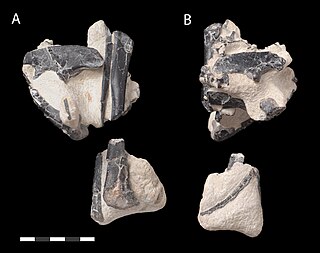The Isle of Wight is one of the richest dinosaur localities in Europe, with over 20 species of dinosaur having been recognised from the early Cretaceous Period, some of which were first identified on the island, as well as the contemporary non-dinosaurian species of crocodile, turtle and pterosaur.

Neovenator is a genus of carcharodontosaurian theropod dinosaur. It is known from several skeletons found in the Early Cretaceous (Hauterivian-Barremian) Wessex Formation on the south coast of the Isle of Wight, southern England. It is one of the best known theropod dinosaurs from the Early Cretaceous of Europe.

Pyroraptor is an extinct genus of paravian dinosaur, probably a dromaeosaurid or unenlagiid, from the Late Cretaceous Ibero-Armorican island, of what is now southern France and northern Spain. It lived during the late Campanian and early Maastrichtian stages, approximately 83.5 to 70.6 million years ago. It is known from a single partial specimen that was found in Provence in 1992, after a forest fire. The animal was named Pyroraptor olympius by Allain and Taquet in 2000.
Calamospondylus is a genus of theropod dinosaur. It lived during the Early Cretaceous and its fossils were found on the Isle of Wight in southern England. The type species is C. oweni.

Calamosaurus was a genus of small theropod dinosaur from the Barremian-age Lower Cretaceous Wessex Formation of the Isle of Wight, England. It is based on two cervical vertebrae, collected by Reverend William Fox.

Eucamerotus was a genus of sauropod dinosaur from the Barremian-age Lower Cretaceous Wessex Formation (Wealden) of the Isle of Wight, England.

Ornithodesmus is a genus of small, dromaeosaurid dinosaur from the Isle of Wight in England, dating to about 125 million years ago. The name was originally assigned to a bird-like sacrum, initially believed to come from a bird and subsequently identified as a pterosaur. More complete pterosaur remains were later assigned to Ornithodesmus, until recently a detailed analysis determined that the original specimen in fact came from a small theropod, specifically a dromaeosaur, making it one of the first dromaeosaurs known to science. All pterosaurian material previously assigned to this genus has been renamed Istiodactylus.

Istiodactylus is a genus of pterosaur that lived during the Early Cretaceous period, about 120 million years ago. The first fossil was discovered on the English Isle of Wight in 1887, and in 1901 became the holotype specimen of a new species, O. latidens, in the genus Ornithodesmus. This species was moved to its own genus, Istiodactylus, in 2001; this name is Greek for "sail finger". More specimens were described in 1913, and Istiodactylus was the only pterosaur known from three-dimensionally preserved fossils for much of the 20th century. In 2006, a species from China, I. sinensis, was assigned to Istiodactylus, but it has also been suggested to belong to a different genus.

Velociraptorinae is a subfamily of the theropod group Dromaeosauridae. The earliest velociraptorines are probably Nuthetes from the United Kingdom, and possibly Deinonychus from North America. However, several indeterminate velociraptorines have also been discovered, dating to the Kimmeridgian stage, in the Late Jurassic Period. These fossils were discovered in the Langenberg quarry, Oker near Goslar, Germany.

The Wessex Formation is a fossil-rich English geological formation that dates from the Berriasian to Barremian stages of the Early Cretaceous. It forms part of the Wealden Group and underlies the younger Vectis Formation and overlies the Durlston Formation. The dominant lithology of this unit is mudstone with some interbedded sandstones. It is part of the strata of the Wessex Basin, exposed in both the Isle of Purbeck and the Isle of Wight. While the Purbeck sections are largely barren of vertebrate remains, the Isle of Wight sections are well known for producing the richest and most diverse fauna in Early Cretaceous Europe.

Vectidraco, is a genus of azhdarchoid pterosaur from the Lower Cretaceous of England.

Europelta is a monospecific genus of nodosaurid dinosaur from Spain that lived during the Early Cretaceous in what is now the lower Escucha Formation of the Teruel Province. The type and only species, Europelta carbonensis, is known from two associated partial skeletons, and represents the most complete ankylosaur known from Europe. Europelta was named in 2013 by James I. Kirkland and colleagues. Europelta has an estimated length of 5 metres and weight of 1.3 tonnes, making it the largest member of the clade Struthiosaurini.

Padillasaurus is an extinct genus of titanosauriform sauropod known from the Early Cretaceous Paja Formation in Colombia. It contains a single species, Padillasaurus leivaensis, known only from a single partial axial skeleton. Initially described as a brachiosaurid, it was considered to be the first South American brachiosaurid ever discovered and named. Before its discovery, the only known brachiosaurid material on the continent was very fragmentary and from the Jurassic period. However, a more recent study finds it to be a basal somphospondylan.

Ornithocheiromorpha is a group of pterosaurs within the suborder Pterodactyloidea. Fossil remains of this group date back from the Early to Late Cretaceous periods, around 140 to 92.5 million years ago. Ornithocheiromorphs were discovered worldwide except Antarctica, though most genera were recovered in Europe, Asia and South America. They were the most diverse and successful pterosaurs during the Early Cretaceous, but throughout the Late Cretaceous they were replaced by better adapted and more advanced pterosaur species such the pteranodontids and azhdarchoids. The Ornithocheiromorpha was defined in 2014 by Andres and colleagues, and they made Ornithocheiromorpha the most inclusive clade containing Ornithocheirus, but not Pteranodon.

Tratayenia is an extinct genus of megaraptoran theropod dinosaurs known from remains found in the Santonian-age Bajo de la Carpa Formation of Argentina. The type and only species, Tratayenia rosalesi, was described in March 2018.

Vallibonavenatrix is a genus of spinosaurid dinosaur from the Early Cretaceous (Barremian) Arcillas de Morella Formation of Castellón, Spain. The type and only species is Vallibonavenatrix cani, known from a partial skeleton.
Wightia is a genus of tapejarid pterosaur recovered from the Lower Cretaceous (Barremian) aged Wessex Formation of the Isle of Wight of England, from which it gets its name. The only species within this genus is W. declivirostris.

Riparovenator is a genus of baryonychine spinosaurid dinosaur from the Early Cretaceous (Barremian) period of Britain, the type species is Riparovenator milnerae.

Brighstoneus is a genus of hadrosauriform dinosaur from the Early Cretaceous Wessex Formation of the Isle of Wight, England. The genus contains a single species, Brighstoneus simmondsi, known from a partial skeleton.

Vectidromeus is an extinct genus of hypsilophodontid ornithopod dinosaur from the Early Cretaceous Wessex Formation of England. The genus contains a single species, V. insularis, known from a partial skeleton belonging to a juvenile individual.






















